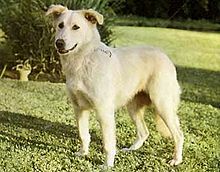Aidi
| Aidi | |||||
|---|---|---|---|---|---|
 White Aidi | |||||
| Other names | Aïdi Atlas Mountain Dog Atlas Shepherd Dog Berber Dog Chien de l'Atlas Chien de montagne de l'Atlas | ||||
| Origin | North Africa | ||||
| |||||
| |||||
| Dog (domestic dog) | |||||
The Aidi (from Tamazight ⴰⵢⴷⵉ, aydi, "dog") is a Berber dog breed used as a livestock guardian, protecting herds of sheep and goats.[1] It also possesses hunting capabilities and good scenting ability. In Morocco,[2] it is often paired in hunting with the Sloughi, which chases down prey that the Aidi has located by scent.[3]
History[]

The Aidi (Berber for dog) is recognized as coming from North Africa (Atlas Mountains of Morocco). The dog has never worked as a sheepdog even though the 1963 standard was published under the name Atlas Sheepdog; this was corrected in 1969. A courageous dog, the Aidi lived and worked in the Atlas Mountains of North Africa, protecting his owner and property from wildcats, other predators, and strangers.[4] This breed has also been called the Berber, after the Berber tribes who utilized it, and bears some resemblance to the Pariah dog who is believed to share its ancestry. As a protector of the desert nomad tribes, the most alert and aggressive dogs were staked around the perimeter of the camp at night. The Aidi has not been highly regarded by the tribes historically, as are most dogs other than the Sloughi and other breeds regarded as noble. However, Moroccans have recently formed a club to protect the purity of the breed which has contributed so much in so many roles, as protector, hunter, police dog, and pet.[5] Although the Aidi has been used primarily as a working dog, he has become more common as a house dog in the country. This breed also makes a good urban pet if he is given tasks and exercise enough to keep him satisfied and happy.[6]
In color and flock guard work they share many characteristics of many livestock guardian dog breeds.
Appearance[]

Standing 52–62 cm (20–24 in) in height and weighing around 55 pounds (25 kg), the Aidi's lean, muscular body is protected by a coarse, thick, weather-resistant coat with a heavy plumed tail. The coat is heavy and soft. The head is bear-like and in proportion to the rest of the body. The breed has a tapered muzzle with a black or brown nose that usually matches the coat. Their jaws are strong with tight black or brown lips. The medium-sized ears are tipped forward and drop slightly. The eyes are medium, with a dark color and dark rims. Coat colours are white, black, black and white, pale red, and tawny.[7][4]
Temperament[]

The Aidi is energetic and highly protective and is said to make an outstanding watchdog. It is a powerful dog that is also agile, alert, and ready for action. As it is a sensitive breed, the dog needs to be given appropriate training from a very young age. It needs to be exposed to as many social conditions as possible so that it makes an ideal family pet.
See also[]
- Dogs portal
- List of dog breeds
References[]
- ^ "Aidi Breed Information: History, Health, Pictures, and more". easypetmd.com. Retrieved 2018-04-05.
- ^ "Fci Standard 247 Aidi" (PDF). Fci.
- ^ Fogle, Bruce. The New Encyclopedia of the Dog. London: Doring Kindersley, 2003. ISBN 978-0-7894-6130-8
- ^ Jump up to: a b Grandjean, Dominique DVM. The Royal Canin Dog Encyclopedia. Paris, France; Aniwa Publishing, 2005.
- ^ Hall, Sian. Dogs of Africa. Loveland, CO: Alpine Blue Ribbon Books, 2003. ISBN 978-1-57779-039-6
- ^ De Prisco, Andrew and Johnson, James B. The Mini-Atlas of Dog Breeds. Neptune City, NJ: TFH Publications, 1990. ISBN 978-0-86622-091-0
- ^ American Rare Breed Association Aidi Standard https://web.archive.org/web/20080310042147/http://www.arba.org/AidiBS.htm
Further reading[]
- Hancock, David (August 31, 2014). Dogs of the Shepherds: A Review of the Pastoral Breeds. ISBN 9781847978097.
- Kojima, Toyoharu (August 28, 2005). Legacy of the Dog: The Ultimate Illustrated Guide (Revised and Updated, 2nd ed.). Chronicle Books LLC. ISBN 9780811851138.
External links[]
- FCI breeds
- Dog breeds originating in Africa
- Livestock guardian dogs
- Breeds originating from Indigenous people